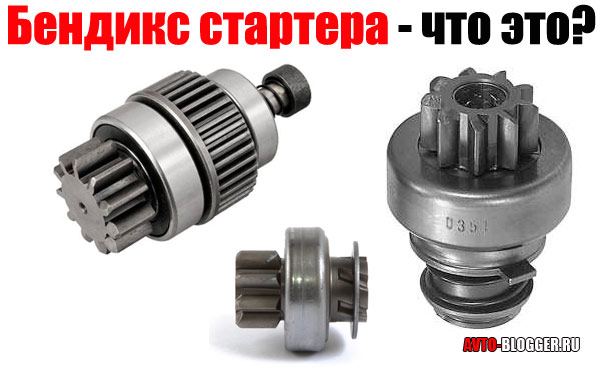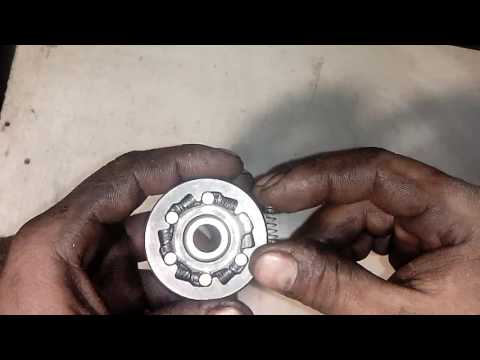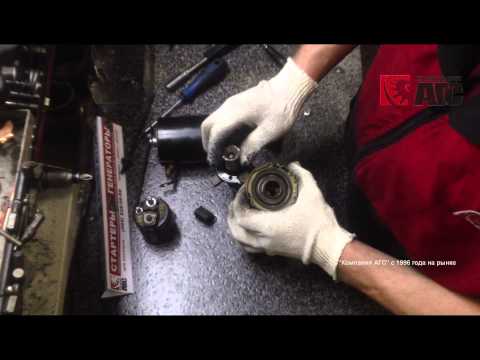
Starter Bendix
Content
Starter Bendix
Starter Bendix (real name - freewheel) is a part designed to transmit torque from the starter of the internal combustion engine of a car, as well as to protect it from high operating speeds at which the engine is running. Starter Bendix - this is a reliable part, and it breaks down quite rarely. usually, the cause of the breakdown is the natural wear of its internal parts or springs. in order to identify breakdowns, we will first deal with the device and the principle of operation of the bendix.
The device and the principle of operation
Most overrunning clutches (we will call them a more popular word among motorists - bendix) consist of leading clip (or outer ring) containing rollers and hold-down springs, and driven cage. The leading clip has wedge channels, which on the one hand have a significant width. It is in them that the spring-loaded rollers rotate. In the narrow part of the channel, the rollers are stopped between the driving and driven clips. As is clear from the above, the role of the springs is to drive the rollers into the narrow part of the channels.
The principle of operation of the bendix is the inertial effect on the gear clutch, which is part of it, until it engages with the ICE flywheel. At a time when the starter is in a non-working state (ICE is off or running in a constant mode), the Bendix clutch is not engaged with the flywheel crown.
Bendix works according to the following algorithm:
The inner part of the bendix
- The ignition key is turned and current from the battery is supplied to the electric starter motor, setting its armature in motion.
- Due to the helical grooves on the inner side of the coupling and the rotational movement, the coupling, under its own weight, slides along the splines until it engages with the flywheel.
- Under the action of the drive gear, the driven cage with the gear begins to rotate.
- In the event that the teeth of the clutch and the flywheel do not coincide, it turns slightly until the moment when they enter into rigid engagement with each other.
- The buffer spring available in the design serves to soften the moment of starting the internal combustion engine. In addition, it is needed to prevent tooth breakage from impact at the moment of gear engagement.
- When the internal combustion engine starts, it begins to rotate the flywheel with a greater angular velocity than the starter previously rotated. Therefore, the coupling is twisted in the opposite direction and slips along the splines of the armature or gearbox (in the case of using a gearbox bendix) and disengages from the flywheel. This saves the starter, which is not designed to work at high speeds.
How to check the starter bendix
If the starter bendix does not turn, then you can check its operation in two ways - visuallyby removing it from the vehicle, and "aurally"... Let's start with the latter, as it is simpler.
As mentioned above, the basic function of the bendix is to engage the flywheel and spin the internal combustion engine. Therefore, if at the time of starting the internal combustion engine you hear that the electric starter motor is spinning, and from the place where it is located, characteristic metal clanging sounds - Is the first sign of a broken bendix.
So further it is required to dismantle the starter and remove the analysis of the bendix in order to inspect it in detail and determine the damage. The procedure for removing and replacing is described by us below.
And so, the bendix was removed, it is necessary to revise it. namely, to check whether it is spinning only in one direction (if in both directions, then it must be replaced) and whether the teeth have eaten. also make sure the spring is not loose. you should also remove the plug from the bendix, check its integrity, signs of wear, if necessary, it must be replaced. In addition, be sure to check if there is play on the armature shaft. If it does, then the bendix should be replaced.
Possible causes of failure
As mentioned above, the rotation of the gear is only possible in the direction of rotation of the starter armature. If rotation in the opposite direction is possible, this is a clear breakdown, that is, the bendix must be repaired or replaced. There may be several reasons for this:
- Reducing the diameter of the work rollers in the cage due to natural wear and tear. The way out is the selection and purchase of balls of the same diameter. Some drivers use other metal objects instead of balls, such as drill bits. However, we still do not recommend doing amateur activities, but buying balls of the desired diameter.
- Presence of flat surfaces on one side of the rollercaused by natural wear and tear. Repair recommendations are similar to the previous point.
- Stitching work surfaces leading or driven cage in those places where they come into contact with the rollers. In this case, repair is hardly possible, since such a development cannot be removed. That is, you need to replace the bendix.
also one cause of failure is the wear of the gear teeth. Since this happens for natural reasons, repair in this case is impossible. it is necessary to either replace the mentioned gear, or the entire bendix.
Since the starter not only experiences strong loads, but also comes into contact with the external environment, it lends itself to such irritants as: moisture, dust, dirt and oil, freewheeling can also occur due to deposits in its grooves and rollers. A sign of such a breakdown is the noise of the armature during the start of the starter and the immobility of the crankshaft.
How to change the starter bendix
usually, in order to change the bendix, you need to remove the starter and disassemble it. Depending on the model of the car, the procedure may have its own characteristics. Let's describe the algorithm from the moment when the starter has already been removed and to replace the bendix it is necessary to disassemble its case:
Repair of the bendix
- Unscrew the tightening bolts and open the housing.
- Remove the bolts securing the retractor relay, then remove the latter. When repairing, it is advisable to clean and wash all the insides.
- Remove the bendix from the axle. To do this, knock down the washer and pick out the restrictive ring.
- Before installing a new bendix, the axle must be lubricated with temperature grease (but no frills).
- usually, the most difficult procedure is to install the retaining ring and washer. To solve this problem, craftsmen use different methods - they burst the ring with open-end wrenches, use special clamps, sliding pliers, and so on.
- After the bendix is installed, coat all rubbing parts of the starter with high-temperature grease. However, do not overdo it with its quantity, because the surplus will only interfere with the operation of the mechanism.
- Check the starter before installing. To do this, use the wires to “light up” the car in the winter. With their help, apply voltage directly from the battery. Connect “minus” to the starter housing, and “plus” to the control contact of the solenoid relay. If the system is working, a click should be heard, and the bendix should move forward. If this does not happen, you need to replace the retractor.

Repair of the bendix

Replacing the starter bendix
A few tips from experienced drivers
Here are some tips for you from experienced motorists that will help you avoid possible problems and inconveniences when repairing or replacing the bendix:
- Before installing a new or refurbished bendix, always check its functionality and the drive of the unit.
- All plastic washers must be intact.
- When buying a new bendix, it is advisable to have the old one with you in order to make sure of their identity. Often, similar parts have minor differences that are not visually remembered.
- If you are disassembling a bendix for the first time, it is advisable to write down the process on paper or fold the individual parts in the order they were dismantled. Or use the manual with photos, the above video instructions and so on.
Price issue
Finally, it is worth adding that the bendix is an inexpensive spare part. For example, a VAZ 2101 bendix (as well as other “classic” VAZs) costs about $ 5 ... 6, the catalog number is DR001C3. And the price of the bendix (nom. 1006209923) for VAZ 2108-2110 cars is $ 12 ... 15. The cost of a bendix for FORD cars of the Focus, Fiesta and Fusion brands is about $10…11. (cat. no. 1006209804). For cars TOYOTA Avensis and Corolla bendix 1006209695 - $ 9 ... 12.
so, often repair is impractical for a bendix. It's easier to buy a new one and simply replace it. Moreover, when repairing its individual parts, there is a high probability of a quick failure of others.
